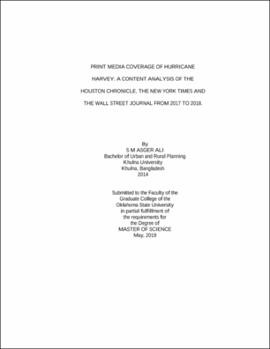| dc.description.abstract | During a crisis moment like a natural disaster, people tend to rely on the mass media to get up-to-date information and stay informed. However, when media are covering crisis news, they lose some objectivity and rather than providing balanced news coverage, media may become critical towards the government and private sectors for their participation in disaster response and recovery processes. This thesis investigated the print media coverage of Hurricane Harvey and utilized data from three newspapers: the New York Times (online); the Wall Street Journal (online) and the Houston Chronicle. This study examined how media used frames to set an agenda during their coverage of Hurricane Harvey. By examining the media’s use of descriptor, quotes, wording, and images, this research explored how media assigned a tone for government and private sectors for their role in Harvey’s response and recovery. Finally, it tested an operationalized definition of disaster capitalism and discussed the usefulness of the term in the context of news media studies. Findings revealed that the human interest frame received the most media attention and the morality frame received less attention. Regarding tone, this study found that the media’s overall tone for government response was neutral. However, the tone for the federal government was slightly negative, while the tone for city and state level of government was slightly positive. Finally, this research found that several indicators of disaster capitalism appear in the print media coverage and they made significant impacts both on media’s frames and tone. For example, frames like “disaster profiteering” and “price gouging” showed how for-profit organizations took advantage of the crisis and exploited the situation for more profit. However other frames related to disaster capitalism did not receive much attention. Further, previous studies showed an extent of privatization was initiated in the aftermath of several natural disasters like the Haiti earthquake and Hurricane Katrina, but apart from growing private investment in buying out flooded homes, this study did not find any significant example of privatization in the aftermath of Harvey. By examining the media’s tone, frame and an operationalized definition of disaster capitalism, this research contributes to the media literature on disaster studies. | |
